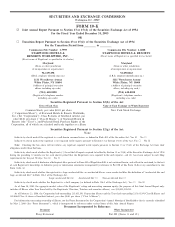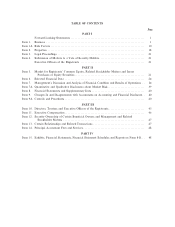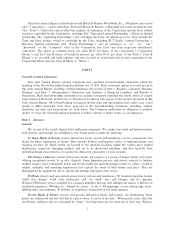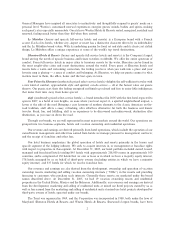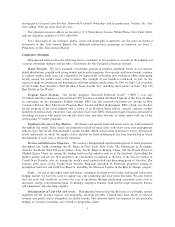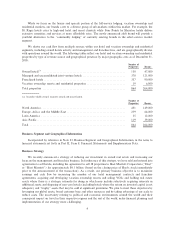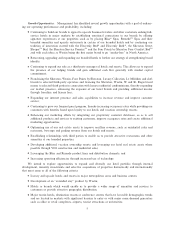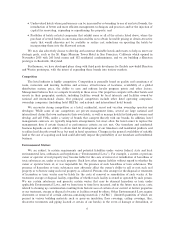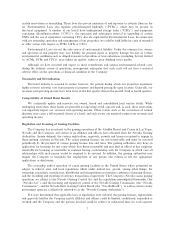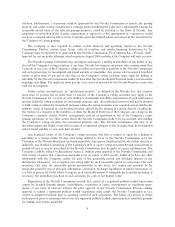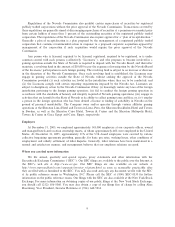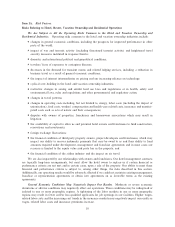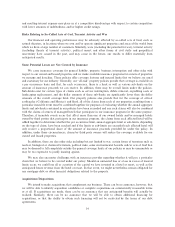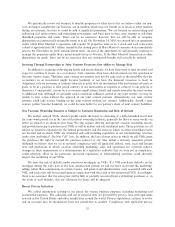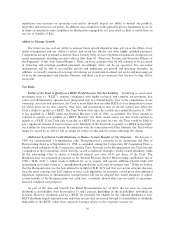Starwood 2005 Annual Report Download - page 10
Download and view the complete annual report
Please find page 10 of the 2005 Starwood annual report below. You can navigate through the pages in the report by either clicking on the pages listed below, or by using the keyword search tool below to find specific information within the annual report.¬Undervalued hotels whose performance can be increased by re-branding to one of our hotel brands, the
introduction of better and more eÇcient management techniques and practices and/or the injection of
capital for renovating, expanding or repositioning the property; and
¬Portfolios of hotels or hotel companies that exhibit some or all of the criteria listed above, where the
purchase of several hotels in one transaction enables us to obtain favorable pricing or obtain attractive
assets that would otherwise not be available or realize cost reductions on operating the hotels by
incorporating them into the Starwood system.
We may also selectively choose to develop and construct desirable hotels and resorts to help us meet our
strategic goals, such as the St. Regis Museum Tower Hotel in San Francisco, California which opened in
November 2005 with 260 hotel rooms and 102 residential condominiums, and we are building a Sheraton
prototype in Rockville, Maryland.
Furthermore, we have developed plans along with third party developers for Öexible new-build Sheraton
and Westin prototypes, with the intent of expanding these brands into tertiary markets.
Competition
The hotel industry is highly competitive. Competition is generally based on quality and consistency of
room, restaurant and meeting facilities and services, attractiveness of locations, availability of a global
distribution system, price, the ability to earn and redeem loyalty program points and other factors.
Management believes that we compete favorably in these areas. Our properties compete with other hotels and
resorts in their geographic markets, including facilities owned by local interests and facilities owned by
national and international chains. Our principal competitors include other hotel operating companies,
ownership companies (including hotel REITs) and national and international hotel brands.
We encounter strong competition as a hotel, residential, resort and vacation ownership operator and
developer. While some of our competitors are private management Ñrms, several are large national and
international chains that own and operate their own hotels, as well as manage hotels for third-party owners and
develop and sell VOIs, under a variety of brands that compete directly with our brands. In addition, hotel
management contracts are typically long-term arrangements, but most allow the hotel owner to replace the
management Ñrm if certain Ñnancial or performance criteria are not met. Our timeshare and residential
business depends on our ability to obtain land for development of our timeshare and residential products and
to utilize land already owned by us but used in hotel operations. Changes in the general availability of suitable
land or the cost of acquiring such land could adversely impact the proÑtability of our timeshare and residential
business.
Environmental Matters
We are subject to certain requirements and potential liabilities under various federal, state and local
environmental laws, ordinances and regulations (""Environmental Laws''). For example, a current or previous
owner or operator of real property may become liable for the costs of removal or remediation of hazardous or
toxic substances on, under or in such property. Such laws often impose liability without regard to whether the
owner or operator knew of, or was responsible for, the presence of such hazardous or toxic substances. The
presence of hazardous or toxic substances may adversely aÅect the owner's ability to sell or rent such real
property or to borrow using such real property as collateral. Persons who arrange for the disposal or treatment
of hazardous or toxic wastes may be liable for the costs of removal or remediation of such wastes at the
treatment, storage or disposal facility, regardless of whether such facility is owned or operated by such person.
We use certain substances and generate certain wastes that may be deemed hazardous or toxic under
applicable Environmental Laws, and we from time to time have incurred, and in the future may incur, costs
related to cleaning up contamination resulting from historic uses of certain of our current or former properties
or our treatment, storage or disposal of wastes at facilities owned by others. Other Environmental Laws require
abatement or removal of certain asbestos-containing materials (""ACMs'') (limited quantities of which are
present in various building materials such as spray-on insulation, Öoor coverings, ceiling coverings, tiles,
decorative treatments and piping located at certain of our hotels) in the event of damage or demolition, or
6



